Secure and Sustainable Sourcing of Plant Tissues for the Exhaustive Exploration of Their Chemodiversity
Abstract
1. Introduction
2. Results and Discussions
2.1. In Vitro Culture Establishment
2.2. Efficiency and Impact of the Surface Sterilization Procedure on Leave Explants
2.3. Alternative Method to Produce Sterile Leave Explants
2.4. Evaluation of the Impact of the Establishment of in Vitro Cultures on Selected Leaf Metabolites
2.4.1. Physalis Angulata L.
2.4.2. Swietenia macrophylla King
2.4.3. Clidemia hirta (L.) D. Don
2.4.4. Calycophyllum spruceanum (Benth.) Hook.f. ex K. Schum.
2.4.5. Vatairea guianensis Aubl.
2.4.6. Peperomia pellucida (L.) Kunth
2.4.7. Phyllanthus brasiliensis (Aubl.) Poir.
2.4.8. Stryphnodendron pulcherrimum (Willd.) Hochr
2.4.9. Conclusions of the Leaves Explants Analyses on All Species
2.4.10. Analyses of Metabolites from Explants Originating from Axenic Plantlets
3. Materials and Methods
3.1. Plant Material and Harvest
3.2. Chemicals
3.2.1. General
3.2.2. Standards
3.3. In Vitro Cultures
3.3.1. Establishment of Cultures from Leaves Collected in Natura
3.3.2. Establishment of Axenic Plantlets Cultures Originating from Seeds Collected in Natura
3.4. Phytochemical Analyses
3.4.1. Extraction Procedure and Sample Preparation for Secondary Metabolite Analysis
3.4.2. LC-MS Analyses
Supplementary Materials
Author Contributions
Funding
Conflicts of Interest
References
- Lautié, E.; Russo, O.; Ducrot, P.; Boutin, J.A. Unraveling plant natural chemical diversity for drug discovery purposes. Front. Pharmacol. 2020, 11, 397. [Google Scholar] [CrossRef]
- Cox, P.A.; Balick, M.J. The ethnobotanical approach to drug discovery. Sci. Am. 1994, 270, 82–87. [Google Scholar] [CrossRef]
- Stokes, T. ORCAstrating plant primary and secondary metabolism. Trends Plant Sci. 2000, 5, 366. [Google Scholar] [CrossRef]
- Newman, D.J.; Cragg, G.M. Natural Products as Sources of New Drugs from 1981 to 2014. J. Nat. Prod. 2016, 79, 629–661. [Google Scholar] [CrossRef] [PubMed]
- Ross, I.A. Medicinal Plants of the World Part 1. Chemical Constituents, Traditional and Modern Medicinal Uses; Humana Press: Totowa, NJ, USA, 1999; ISBN 0896035425. [Google Scholar]
- Ross, I.A. Medicinal Plants of the World Part 2. Chemical Constituents, Traditional and Modern Medicinal Uses; Humana Press: Totowa, NJ, USA, 2001; ISBN 0896038777. [Google Scholar]
- de Smet, P.A.; Rivier, L. A general outlook on ethnopharmacology. J. Ethnopharmacol. 1989, 25, 127–138. [Google Scholar] [CrossRef]
- Ningthoujam, S.S.; Talukdar, A.D.; Potsangbam, K.S.; Choudhury, M.D. Challenges in developing medicinal plant databases for sharing ethnopharmacological knowledge. J. Ethnopharmacol. 2012, 141, 9–32. [Google Scholar] [CrossRef] [PubMed]
- Lautié, E.; Quintero, R.; Fliniaux, M.-A.; Villarreal, M.-L. Selection methodology with scoring system: Application to Mexican plants producing podophyllotoxin related lignans. J. Ethnopharmacol. 2008, 120, 402–412. [Google Scholar] [CrossRef] [PubMed]
- Malone, M.H. The pharmacological evaluation of natural products--general and specific approaches to screening ethnopharmaceuticals. J. Ethnopharmacol. 1983, 8, 127–147. [Google Scholar] [CrossRef]
- Bousserouel, H.; Litaudon, M.; Morleo, B.; Martin, M.-T.; Thoison, O.; Nosjean, O.; Boutin, J.A.; Renard, P.; Sévenet, T. New biologically active linear triterpenes from the bark of three new-caledonian Cupaniopsis species. Tetrahedron 2005, 61, 845–851. [Google Scholar] [CrossRef]
- Da Silva, M.N.; Arruda, M.S.P.; Castro, K.C.F.; da Silva, M.F.d.G.F.; Fernandes, J.B.; Vieira, P.C. Limonoids of the phragmalin type from Swietenia macrophylla and their chemotaxonomic significance. J. Nat. Prod. 2008, 71, 1983–1987. [Google Scholar] [CrossRef]
- Litaudon, M.; Bousserouel, H.; Awang, K.; Nosjean, O.; Martin, M.T.; Dau, M.E.T.H.; Hadi, H.A.; Boutin, J.A.; Sévenet, T.; Guéritte, F. A Dimeric sesquiterpenoid from a Malaysian Meiogyne as a new inhibitor of Bcl-xL/BakBH3 domain peptide interaction. J. Nat. Prod. 2009, 72, 480–483. [Google Scholar] [CrossRef]
- Litaudon, M.; Jolly, C.; Le Callonec, C.; Cuong, D.D.; Retailleau, P.; Nosjean, O.; van Nguyen, H.; Pfeiffer, B.; Boutin, J.A.; Gueritte, F. Cytotoxic pentacyclic triterpenoids from Combretum sundaicum and Lantana camara as inhibitors of Bcl-xL/BakBH3 domain peptide interaction. J. Nat. Prod. 2009, 72, 1314–1320. [Google Scholar] [CrossRef]
- Olivon, F.; Nothias, L.-F.; Dumontet, V.; Retailleau, P.; Berger, S.; Ferry, G.; Cohen, W.; Pfeiffer, B.; Boutin, J.A.; Scalbert, E.; et al. Natural Inhibitors of the RhoA-p115 Complex from the Bark of Meiogyne baillonii. J. Nat. Prod. 2018, 81, 1610–1618. [Google Scholar] [CrossRef] [PubMed]
- Sharma, S.B.; Gupta, R. Drug development from natural resource: A systematic approach. Mini Rev. Med. Chem. 2015, 15, 52–57. [Google Scholar] [CrossRef] [PubMed]
- Weller, M.G. A unifying review of bioassay-guided fractionation, effect-directed analysis and related techniques. Sensors 2012, 12, 9181–9209. [Google Scholar] [CrossRef]
- Atanasov, A.G.; Waltenberger, B.; Pferschy-Wenzig, E.-M.; Linder, T.; Wawrosch, C.; Uhrin, P.; Temml, V.; Wang, L.; Schwaiger, S.; Heiss, E.H.; et al. Discovery and resupply of pharmacologically active plant-derived natural products: A review. Biotechnol. Adv. 2015, 33, 1582–1614. [Google Scholar] [CrossRef] [PubMed]
- Mustafa, N.R.; De Winter, W.; Van Iren, F.; Verpoorte, R. Initiation, growth and cryopreservation of plant cell suspension cultures. Nat. Protoc. 2011, 6, 715–742. [Google Scholar] [CrossRef] [PubMed]
- Wang, J.; Li, J.-l.; Li, J.; Li, J.-x.; Liu, S.-j.; Huang, L.-q.; Gao, W.-y. Production of Active Compounds in Medicinal Plants: From Plant Tissue Culture to Biosynthesis. Chin. Herbal Med. 2017, 9, 115–125. [Google Scholar] [CrossRef]
- Dias, M.I.; Sousa, M.J.; Alves, R.C.; Ferreira, I.C.F.R. Exploring plant tissue culture to improve the production of phenolic compounds: A review. Ind. Crop. Prod. 2016, 82, 9–22. [Google Scholar] [CrossRef]
- Pan, J.; Zhao, F.; Zhang, G.; Pan, Y.; Sun, L.; Bao, N.; Qin, P.; Chen, L.; Yu, J.; Zhang, Y.; et al. Control of de novo root regeneration efficiency by developmental status of Arabidopsis leaf explants. J. Genet. Genom. 2019, 46, 133–140. [Google Scholar] [CrossRef] [PubMed]
- Zhang, W.-N.; Tong, W.-Y. Chemical Constituents and Biological Activities of Plants from the Genus Physalis. Chem. Biodivers. 2016, 13, 48–65. [Google Scholar] [CrossRef] [PubMed]
- Bhusare, B.P.; John, C.K.; Bhatt, V.P.; Nikam, T.D. Induction of somatic embryogenesis in leaf and root explants of Digitalis lanata Ehrh.: Direct and indirect method. South Afr. J. Bot. 2020, 130, 356–365. [Google Scholar] [CrossRef]
- Poobathy, R.; Zakaria, R.; Murugaiyah, V.; Subramaniam, S. Surface sterilization and micropropagation of Ludisia discolor. Biocatal. Agric. Biotechnol. 2019, 22, 101380. [Google Scholar] [CrossRef]
- Kuppusamy, S.; Ramanathan, S.; Sengodagounder, S.; Senniappan, C.; Shanmuganathan, R.; Brindhadevi, K.; Kaliannan, T. Optimizing the sterilization methods for initiation of the five different clones of the Eucalyptus hybrid species. Biocatal. Agric. Biotechnol. 2019, 22, 101361. [Google Scholar] [CrossRef]
- Bhadane, B.S.; Patil, R.H. Data on the cost effective surface sterilization method for C.carandas (L.) seeds and callus induction from aseptic seedling. Data Brief 2016, 7, 1551–1555. [Google Scholar] [CrossRef] [PubMed][Green Version]
- Gangopadhyay, M.; Nandi, S.; Bardhan Roy, S.K. An Efficient Ex Plant Sterilization Protocol for Reducing Microbial Contamination of Solanum tuberosum CV. Kufri Jyoti for Establishing Micropropagation in Rainy Season. J. Bas. Appl. Pl. Sci. 2017, 1, 108. [Google Scholar]
- Patil, K.S.; Bhalsing, S.R. Efficient micropropagation and assessment of genetic fidelity of Boerhaavia diffusa L- High trade medicinal plant. Physiol. Mol. Biol. Plants 2015, 21, 425–432. [Google Scholar] [CrossRef][Green Version]
- Amin Dalal, M.; Sharma, B.B.; Srinivasa Rao, M. Studies on stock plant treatment and initiation culture mode in control of oxidative browning in in vitro cultures of grapevine. Sci. Hortic. 1992, 51, 35–41. [Google Scholar] [CrossRef]
- Suekawa, M.; Fujikawa, Y.; Esaka, M. Exogenous proline has favorable effects on growth and browning suppression in rice but not in tobacco. Plant Physiol. Biochem. 2019, 142, 1–7. [Google Scholar] [CrossRef]
- Gao, J.; Xue, J.; Xue, Y.; Liu, R.; Ren, X.; Wang, S.; Zhang, X. Transcriptome sequencing and identification of key callus browning-related genes from petiole callus of tree peony (Paeonia suffruticosa cv. Kao) cultured on media with three browning inhibitors. Plant Physiol. Biochem. 2020, 149, 36–49. [Google Scholar] [CrossRef]
- Jones, A.M.P.; Saxena, P.K. Inhibition of phenylpropanoid biosynthesis in Artemisia annua L.: A novel approach to reduce oxidative browning in plant tissue culture. PLoS ONE 2013, 8, e76802. [Google Scholar] [CrossRef] [PubMed]
- Abohatem, M.; Zouine, J.; El Hadrami, I. Low concentrations of BAP and high rate of subcultures improve the establishment and multiplication of somatic embryos in date palm suspension cultures by limiting oxidative browning associated with high levels of total phenols and peroxidase activities. Sci. Hortic. 2011, 130, 344–348. [Google Scholar] [CrossRef]
- Madhusudhanan, K.; Rahiman, B.A. The Effect of Activated Charcoal Supplemented Media to Browning of In Vitro Cultures of Piper species. Biol. Plant. 2000, 43, 297–299. [Google Scholar] [CrossRef]
- Niedz, R.P.; Bausher, M.G. Control of In vitro contamination of explants from greenhouse- and field-grown trees. Vitr. Cell. Dev. Biol. Plant 2002, 38, 468–471. [Google Scholar] [CrossRef]
- Imseng, N.; Schillberg, S.; Schürch, C.; Schmid, D.; Schütte, K.; Gorr, G.; Eibl, D.; Eibl, R. Suspension Culture of Plant Cells Under Heterotrophic Conditions. In Industrial Scale Suspension Culture of Living Cells; Meyer, H.-P., Schmidhalter, D.R., Eds.; Wiley-VCH Verlag GmbH & Co. KGaA: Weinheim, Germany, 2014; pp. 244–258. ISBN 9783527683321. [Google Scholar]
- Mihaljevic, I.; Dugalic, K.; Tomas, V.; Viljevac, M.; Pranjic, A.; Cmelik, Z.; Puskar, B.; Jurkovic, Z. In vitro sterilization procedures for micropropagation of ‘oblacinska’ sour cherry. J. Agric. Sci. Belgrade 2013, 58, 117–126. [Google Scholar] [CrossRef]
- Da Silva, R.R.P.; da Silva, B.J.M.; Rodrigues, A.P.D.; Farias, L.H.S.; da Silva, M.N.; Alves, D.T.V.; Bastos, G.N.T.; do Nascimento, J.L.M.; Silva, E.O. In vitro biological action of aqueous extract from roots of Physalis angulata against Leishmania (Leishmania) amazonensis. BMC Complement. Altern. Med. 2015, 15, 249. [Google Scholar] [CrossRef]
- Pamplona, S.; Sá, P.; Lopes, D.; Costa, E.; Yamada, E.; e Silva, C.; Arruda, M.; Souza, J.; da Silva, M. In Vitro Cytoprotective Effects and Antioxidant Capacity of Phenolic Compounds from the Leaves of Swietenia macrophylla. Molecules 2015, 20, 18777–18788. [Google Scholar] [CrossRef]
- Pamplona, S.; Arruda, M.; Castro, K.; e Silva, C.; Ferreira, A.; da Silva, M.; Ohashi, O.; da Silva, M. Phragmalin Limonoids from Swietenia macrophylla and Their Antifeedant Assay against Mahogany Predator. J. Braz. Chem. Soc. 2018, 29, 1621–1629. [Google Scholar] [CrossRef]
- El Abdellaoui, S.; Destandau, E.; Toribio, A.; Elfakir, C.; Lafosse, M.; Renimel, I.; André, P.; Cancellieri, P.; Landemarre, L. Bioactive molecules in Kalanchoe pinnata leaves: Extraction, purification, and identification. Anal. Bioanal. Chem. 2010, 398, 1329–1338. [Google Scholar] [CrossRef]
- Souza, R.; da Silva, G.; Arruda, A.; da Silva, M.; Santos, A.; Grisólia, D.; Silva, M.; Salgado, C.; Arruda, M.S. A New Prenylisoflavone from the Antifungal Extract of Leaves of Vatairea guianensis Aubl. J. Braz. Chem. Soc. 2017, 28, 1132–1136. [Google Scholar] [CrossRef]
- de Souza, R.F.; Marinho, V.H.S.; Silva, G.A.d.; Costa-Júnior, L.M.; Silva, J.K.R.d.; Bastos, G.N.T.; Arruda, A.C.; Silva, M.N.d.; Arruda, M.S.P. New Isoflavones from the Leaves of Vatairea guianensis Aublé. J. Braz. Chem. Soc. 2013, 24, 1857–1863. [Google Scholar] [CrossRef]
- Souza, R.F.d.; Silva, J.K.R.d.; Silva, G.A.d.; Arruda, A.C.; Silva, M.N.d.; Arruda, M.S.P. Chemical Study and Evaluation of the Antioxidant Potential of Sapwood of Vatairea guianensis Aubl. Revista Virtual de Química 2015, 7. [Google Scholar] [CrossRef]
- Bayma, J.D.; Arruda, M.S.; Müller, A.H.; Arruda, A.C.; Canto, W.C. A dimeric ArC2 compound from Peperomia pellucida. Phytochemistry 2000, 55, 779–782. [Google Scholar] [CrossRef]
- Silva, R.M.F.; Ribeiro, J.F.A.; Freitas, M.C.C.; Arruda, M.S.P.; Nascimento, M.N.; Barbosa, W.L.R.; Rolim Neto, P.J. Caracterização físico-química e análises por espectrofotometria e cromatografia de Peperomia pellucida L. (H.B.K.). J. Nat. Prod 2013, 15, 717–726. [Google Scholar] [CrossRef][Green Version]
- Borges, L.d.C.; Negrão-Neto, R.; Pamplona, S.; Fernandes, L.; Barros, M.; Fontes-Júnior, E.; Maia, C.; e Silva, C.Y.Y.; Silva, M.N.D. Anti-Inflammatory and Antinociceptive Studies of Hydroalcoholic Extract from the Leaves of Phyllanthus brasiliensis (Aubl.) Poir. and Isolation of 5-O-β-d-Glucopyranosyljusticidin B and Six Other Lignans. Molecules 2018, 23, 941. [Google Scholar] [CrossRef]
- Rathi, V. A comprehensive review of Physalis Angulata. WJPR 2017, 1503–1512. [Google Scholar] [CrossRef]
- Engström, M.T.; Pälijärvi, M.; Salminen, J.-P. Rapid Fingerprint Analysis of Plant Extracts for Ellagitannins, Gallic Acid, and Quinic Acid Derivatives and Quercetin-, Kaempferol- and Myricetin-Based Flavonol Glycosides by UPLC-QqQ-MS/MS. J. Agric. Food Chem. 2015, 63, 4068–4079. [Google Scholar] [CrossRef]
- Abdellaoui, S.E.; Destandau, E.; Krolikiewicz-Renimel, I.; Cancellieri, P.; Toribio, A.; Jeronimo-Monteiro, V.; Landemarre, L.; André, P.; Elfakir, C. Centrifugal partition chromatography for antibacterial bio-guided fractionation of Clidemia hirta roots. Sep. Purif. Technol. 2014, 123, 221–228. [Google Scholar] [CrossRef]
- Willems, J.L.; Khamis, M.M.; Mohammed Saeid, W.; Purves, R.W.; Katselis, G.; Low, N.H.; El-Aneed, A. Analysis of a series of chlorogenic acid isomers using differential ion mobility and tandem mass spectrometry. Anal. Chim. Acta 2016, 933, 164–174. [Google Scholar] [CrossRef]
- Kumar, S.; Singh, A.; Kumar, B. Identification and characterization of phenolics and terpenoids from ethanolic extracts of Phyllanthus species by HPLC-ESI-QTOF-MS/MS. J. Pharm. Anal. 2017, 7, 214–222. [Google Scholar] [CrossRef]
- Lv, Q.; Luo, F.; Zhao, X.; Liu, Y.; Hu, G.; Sun, C.; Li, X.; Chen, K. Identification of proanthocyanidins from litchi (Litchi chinensis Sonn.) pulp by LC-ESI-Q-TOF-MS and their antioxidant activity. PLoS ONE 2015, 10, e0120480. [Google Scholar] [CrossRef]
- Rodrigues, C.M.; Rinaldo, D.; dos Santos, L.C.; Montoro, P.; Piacente, S.; Pizza, C.; Hiruma-Lima, C.A.; Brito, A.R.M.S.; Vilegas, W. Metabolic fingerprinting using direct flow injection electrospray ionization tandem mass spectrometry for the characterization of proanthocyanidins from the barks of Hancornia speciosa. Rapid Commun. Mass Spectrom. 2007, 21, 1907–1914. [Google Scholar] [CrossRef]
- Yang, W.-Z.; Qiao, X.; Bo, T.; Wang, Q.; Guo, D.-A.; Ye, M. Low energy induced homolytic fragmentation of flavonol 3-O-glycosides by negative electrospray ionization tandem mass spectrometry. Rapid Commun. Mass Spectrom. 2014, 28, 385–395. [Google Scholar] [CrossRef]
- Tahara, S.; Nakahara, S.; Mizutani, J.; Ingham, J.L. Fungal Transformation of the Antifungal Isoflavone Luteone. Agric. Biol. Chem. 1984, 48, 1471–1477. [Google Scholar] [CrossRef]
- Campanero, M.A.; Escolar, M.; Perez, G.; Garcia-Quetglas, E.; Sadaba, B.; Azanza, J.R. Simultaneous determination of diosmin and diosmetin in human plasma by ion trap liquid chromatography-atmospheric pressure chemical ionization tandem mass spectrometry: Application to a clinical pharmacokinetic study. J. Pharm. Biomed. Anal. 2010, 51, 875–881. [Google Scholar] [CrossRef] [PubMed]
- Silvestro, L.; Tarcomnicu, I.; Dulea, C.; Attili, N.R.B.N.; Ciuca, V.; Peru, D.; Rizea Savu, S. Confirmation of diosmetin 3-O-glucuronide as major metabolite of diosmin in humans, using micro-liquid-chromatography-mass spectrometry and ion mobility mass spectrometry. Anal. Bioanal. Chem. 2013, 405, 8295–8310. [Google Scholar] [CrossRef] [PubMed]
- Piccinelli, A.L.; Campone, L.; Dal Piaz, F.; Cuesta-Rubio, O.; Rastrelli, L. Fragmentation pathways of polycyclic polyisoprenylated benzophenones and degradation profile of nemorosone by multiple-stage tandem mass spectrometry. J. Am. Soc. Mass Spectrom. 2009, 20, 1688–1698. [Google Scholar] [CrossRef] [PubMed][Green Version]
- Soares, M.G.; Felippe, A.P.V.d.; Guimarães, E.F.; Kato, M.J.; Ellena, J.; Doriguetto, A.C. 2-Hydroxy-4,6-dimethoxyacetophenone from leaves of Peperomia glabella. J. Braz. Chem. Soc. 2006, 17. [Google Scholar] [CrossRef]
- Felippe, L.G.; Baldoqui, D.C.; Kato, M.J.; Bolzani, V.d.S.; Guimarães, E.F.; Cicarelli, R.M.B.; Furlan, M. Trypanocidal tetrahydrofuran lignans from Peperomia blanda. Phytochemistry 2008, 69, 445–450. [Google Scholar] [CrossRef] [PubMed]
- Galaverna, R.S.; Sampaio, P.T.B.; Barata, L.E.S.; Eberlin, M.N.; Fidelis, C.H.V. Differentiation of two morphologically similar Amazonian Aniba species by mass spectrometry leaf fingerprinting. Anal. Methods 2015, 7, 1984–1990. [Google Scholar] [CrossRef]
- Xiao, X.; Xu, L.; Hu, H.; Yang, Y.; Zhang, X.; Peng, Y.; Xiao, P. DPPH Radical Scavenging and Postprandial Hyperglycemia Inhibition Activities and Flavonoid Composition Analysis of Hawk Tea by UPLC-DAD and UPLC-Q/TOF MSE. Molecules 2017, 22, 1622. [Google Scholar] [CrossRef]
- He, J.; Feng, Y.; Ouyang, H.-Z.; Yu, B.; Chang, Y.-X.; Pan, G.-X.; Dong, G.-Y.; Wang, T.; Gao, X.-M. A sensitive LC-MS/MS method for simultaneous determination of six flavonoids in rat plasma: Application to a pharmacokinetic study of total flavonoids from mulberry leaves. J. Pharm. Biomed. Anal. 2013, 84, 189–195. [Google Scholar] [CrossRef]
- Fu, B.; Ji, X.; Zhao, M.; He, F.; Wang, X.; Wang, Y.; Liu, P.; Niu, L. The influence of light quality on the accumulation of flavonoids in tobacco (Nicotiana tabacum L.) leaves. J. Photochem. Photobiol. B Biol. 2016, 162, 544–549. [Google Scholar] [CrossRef]
- Callemien, D.; Collin, S. Involvement of flavanoids in beer color instability during storage. J. Agric. Food Chem. 2007, 55, 9066–9073. [Google Scholar] [CrossRef]
- Felfili, J.M.; Silva-Junior, M.C.; Dias, B.J.; Rezende, A.V. Estudo fenológico de Stryphnodendron adstringens (Mart.) Coville no cerrado sensu stricto da Fazenda Água Limpa no Distrito Federal, Brasil. Rev. Bras. Bot 1999, 22, 83–90. [Google Scholar]
- Lima, T.C.D.D.; Cardoso, M.V.; Modesto, T.; Oliveira, A.L.D.B.; Silva, M.N.D.; Monteiro, M.C. Breve revisão etnobotânica, fitoquímica e farmacologia de Stryphnodendron adstringens utilizada na Amazônia. Revista Fitos 2016, 10, 329–338. [Google Scholar] [CrossRef][Green Version]
- Makkar, H.P.; Blümmel, M.; Becker, K. Formation of complexes between polyvinyl pyrrolidones or polyethylene glycols and tannins, and their implication in gas production and true digestibility in in vitro techniques. Br. J. Nutr. 1995, 73, 897–913. [Google Scholar] [CrossRef] [PubMed]
- Murashige, T.; Skoog, F. A Revised Medium for Rapid Growth and Bio Assays with Tobacco Tissue Cultures. Physiol. Plant 1962, 15, 473–497. [Google Scholar] [CrossRef]
- Da Costa, M.F.; Galaverna, R.S.; Pudenzi, M.A.; Ruiz, A.L.T.G.; de Carvalho, J.E.; Eberlin, M.N.; Santos, C.d. Profiles of phenolic compounds by FT-ICR MS and antioxidative and antiproliferative activities of Stryphnodendron obovatum Benth leaf extracts. Anal. Methods 2016, 8, 6056–6063. [Google Scholar] [CrossRef]
- Li, A.; Hou, X.; Wei, Y. Fast screening of flavonoids from switchgrass and Mikania micrantha by liquid chromatography hybrid-ion trap time-of-flight mass spectrometry. Anal. Methods 2018, 10, 109–122. [Google Scholar] [CrossRef]
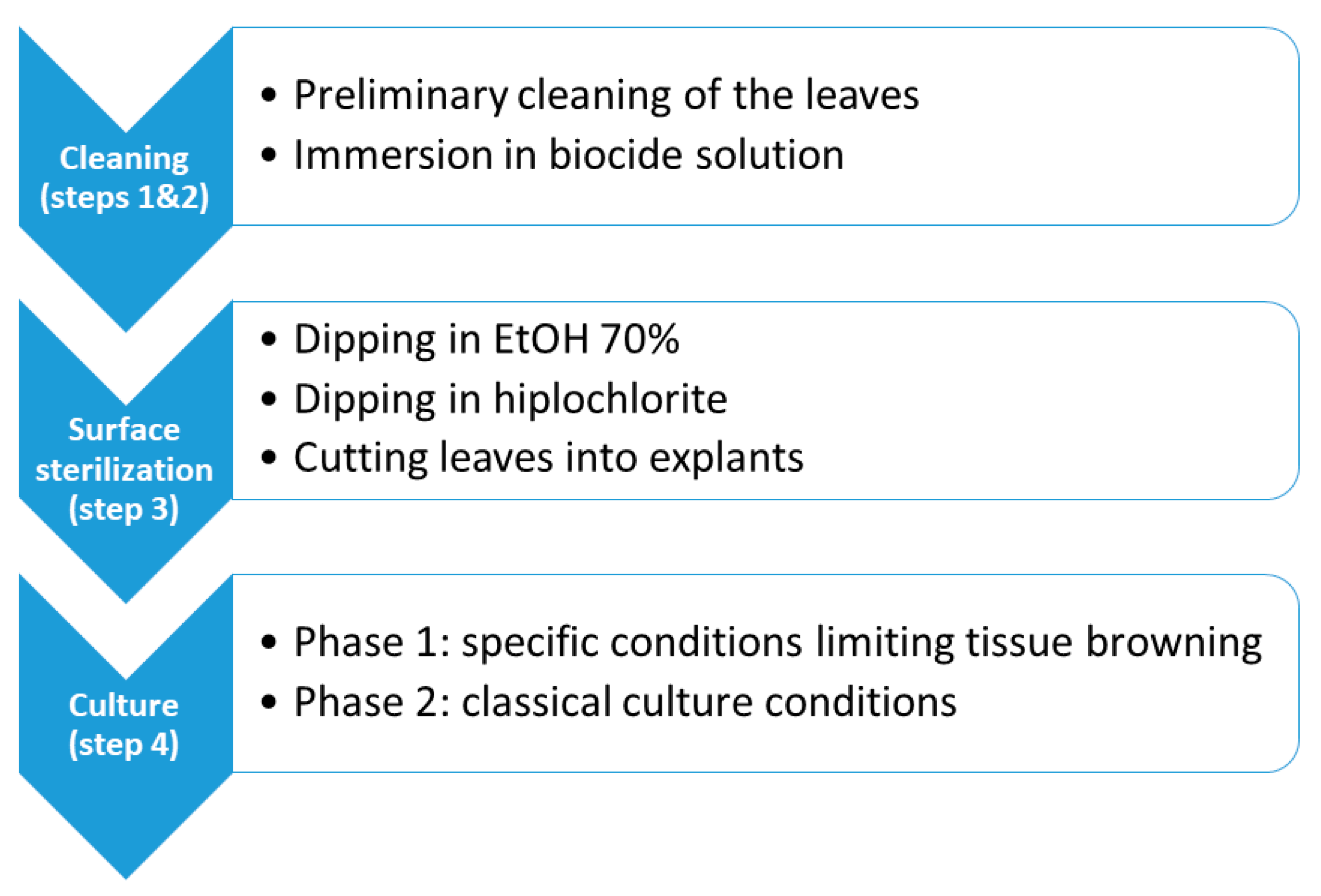

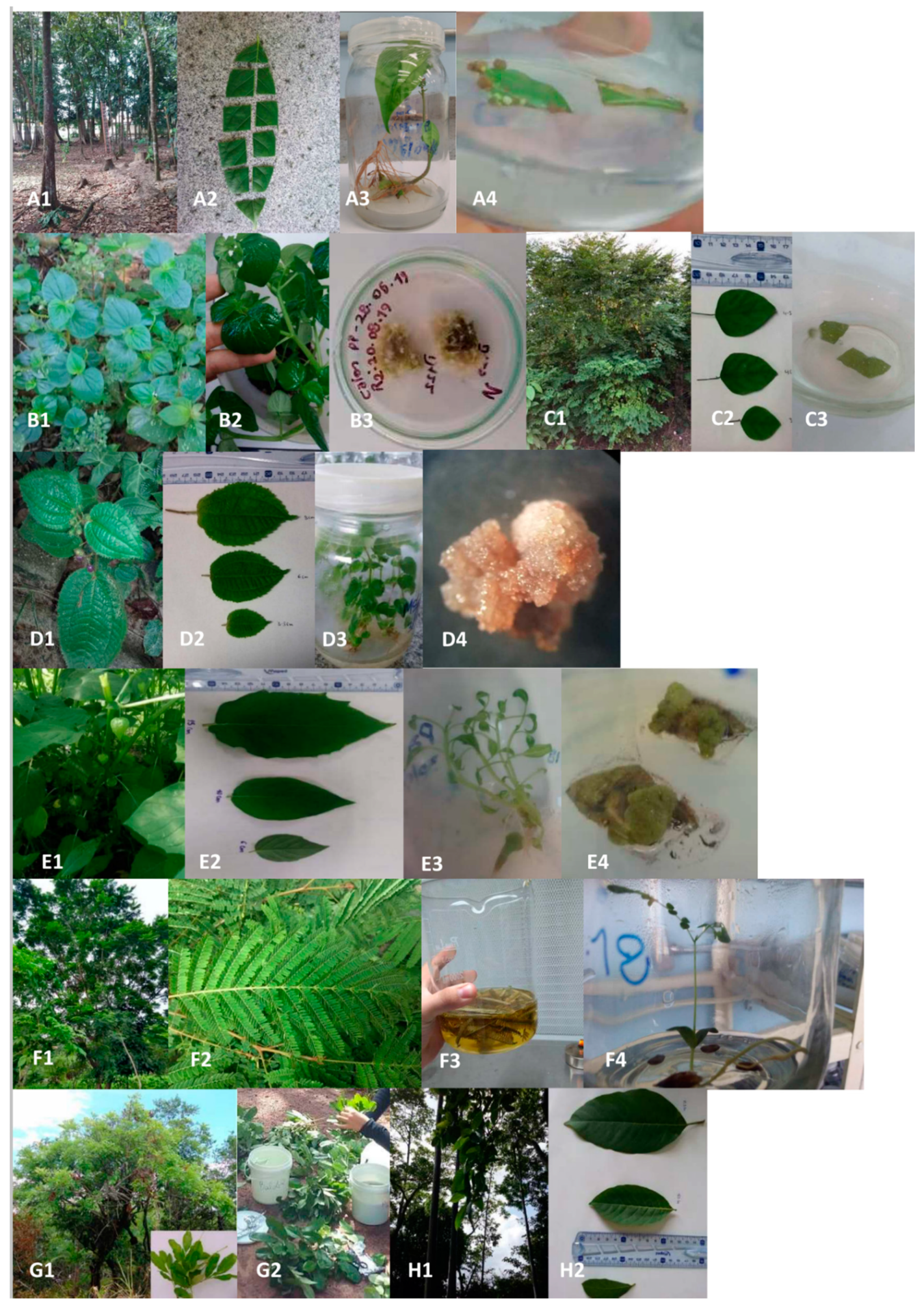
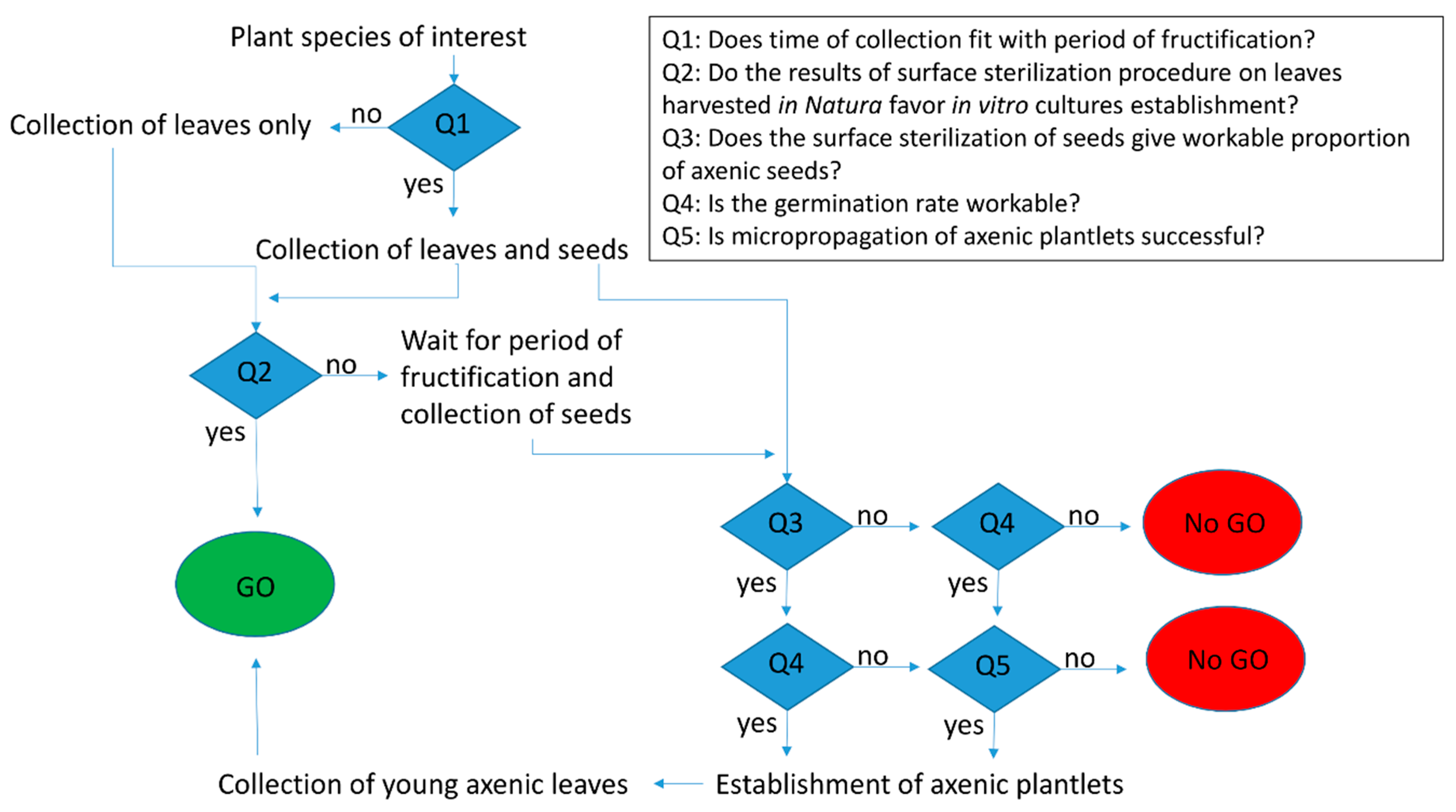
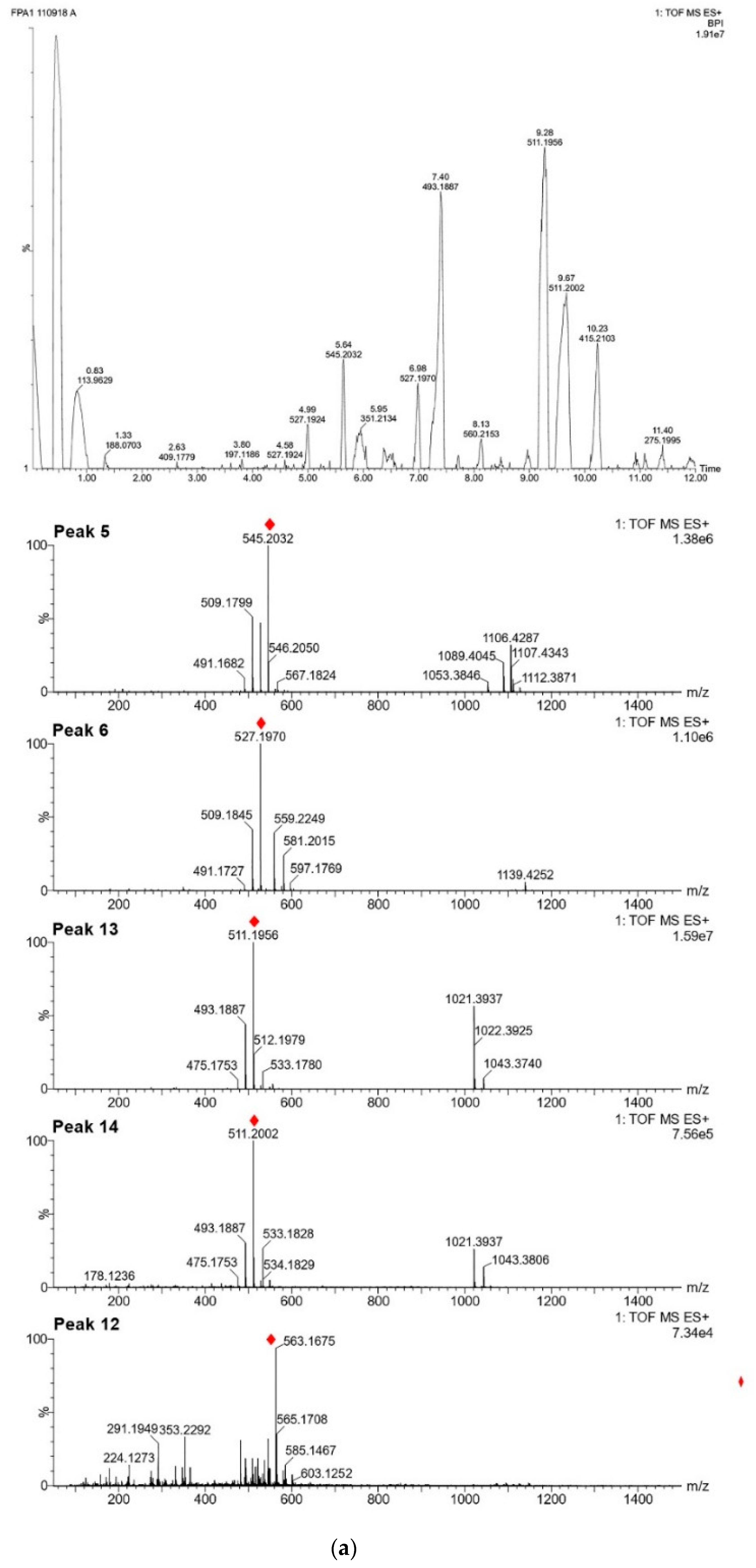
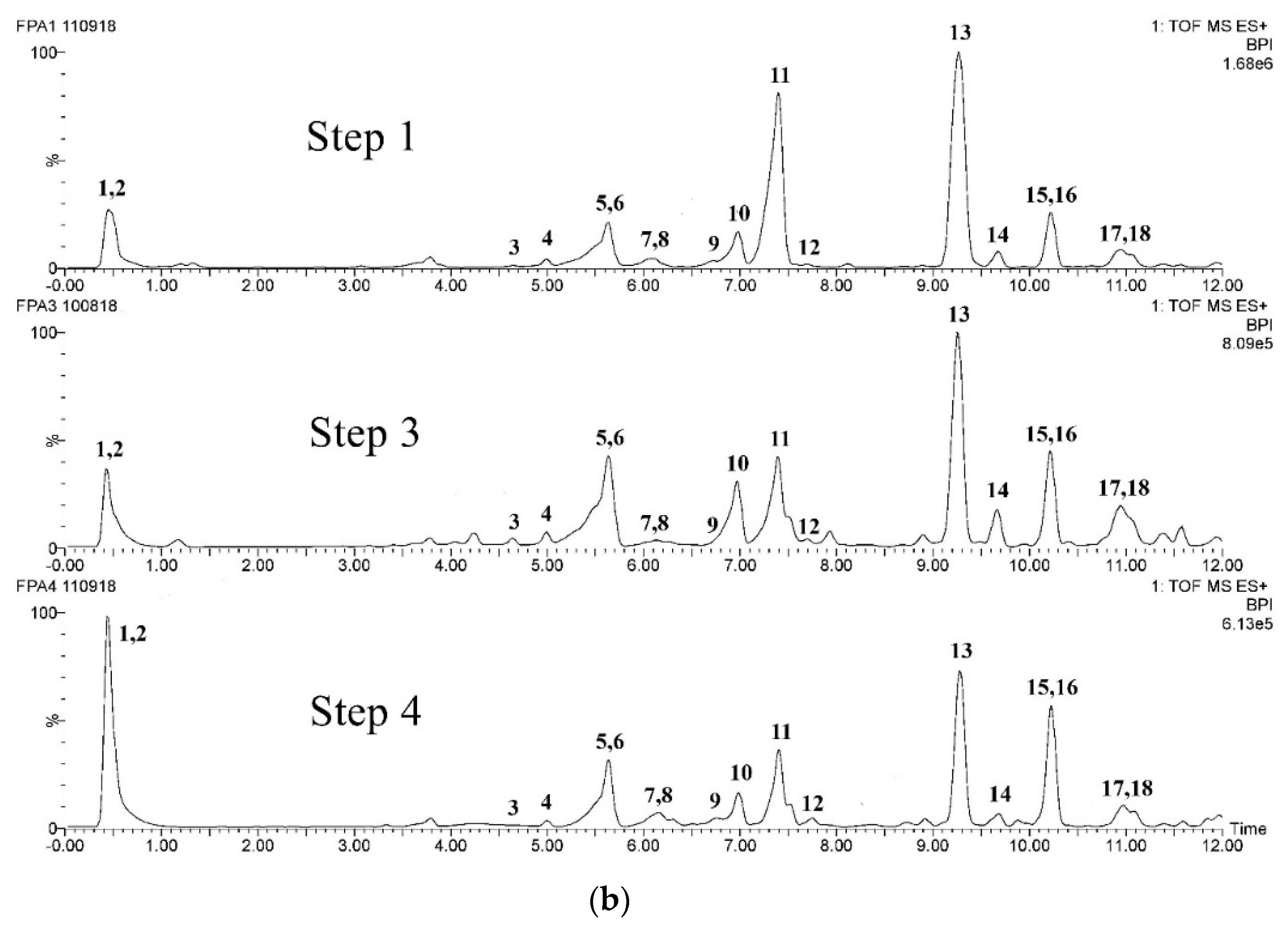

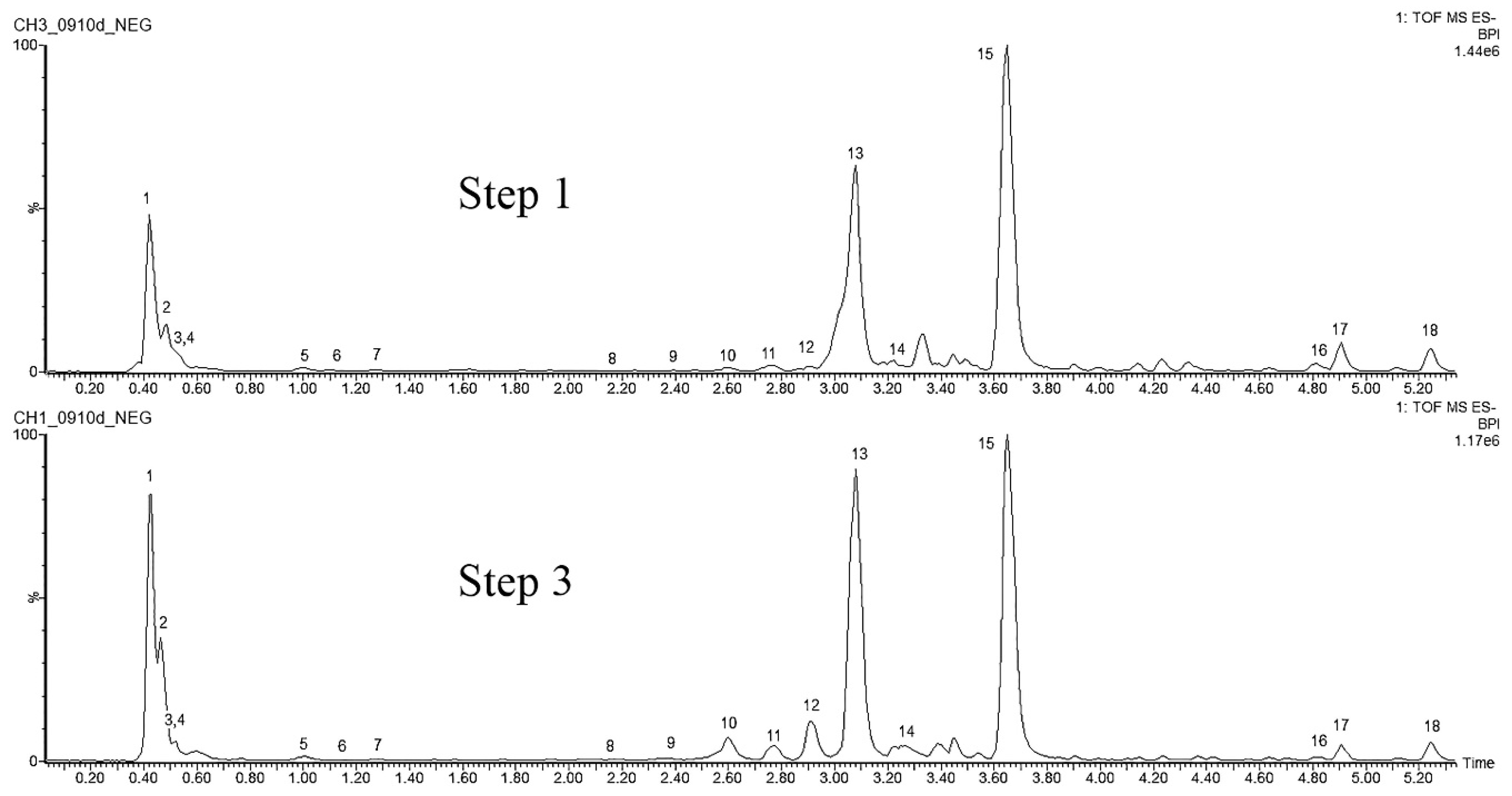
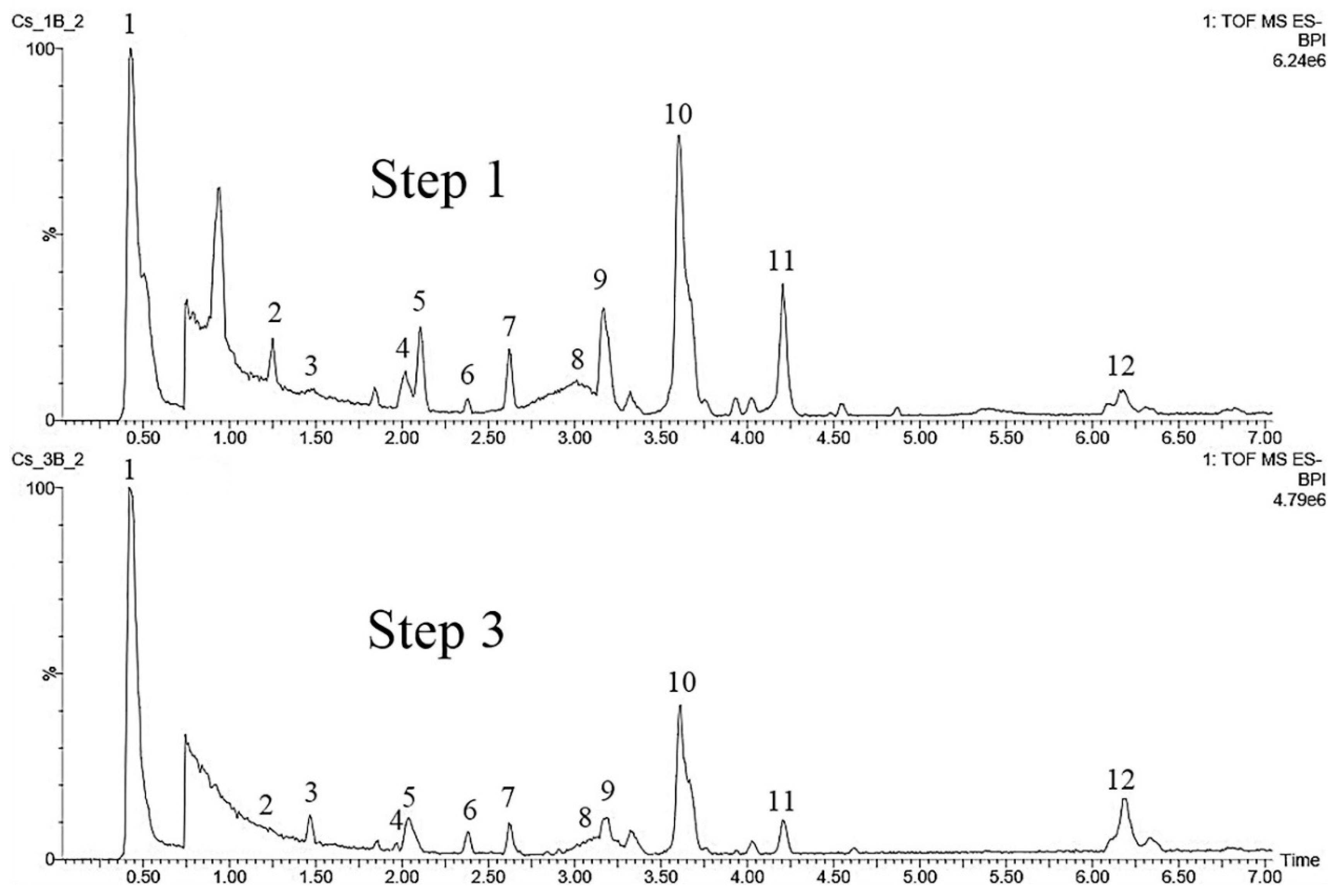
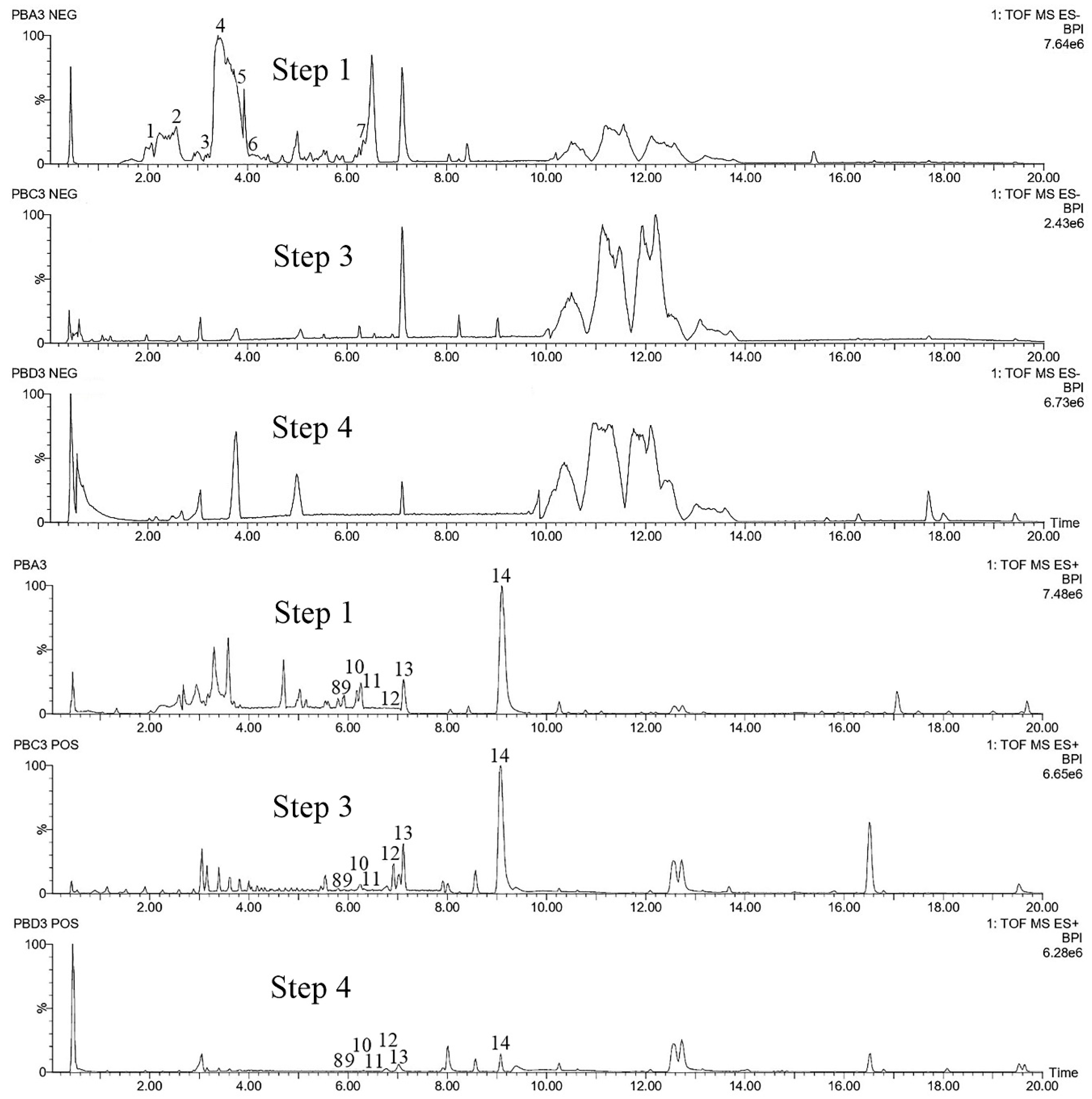
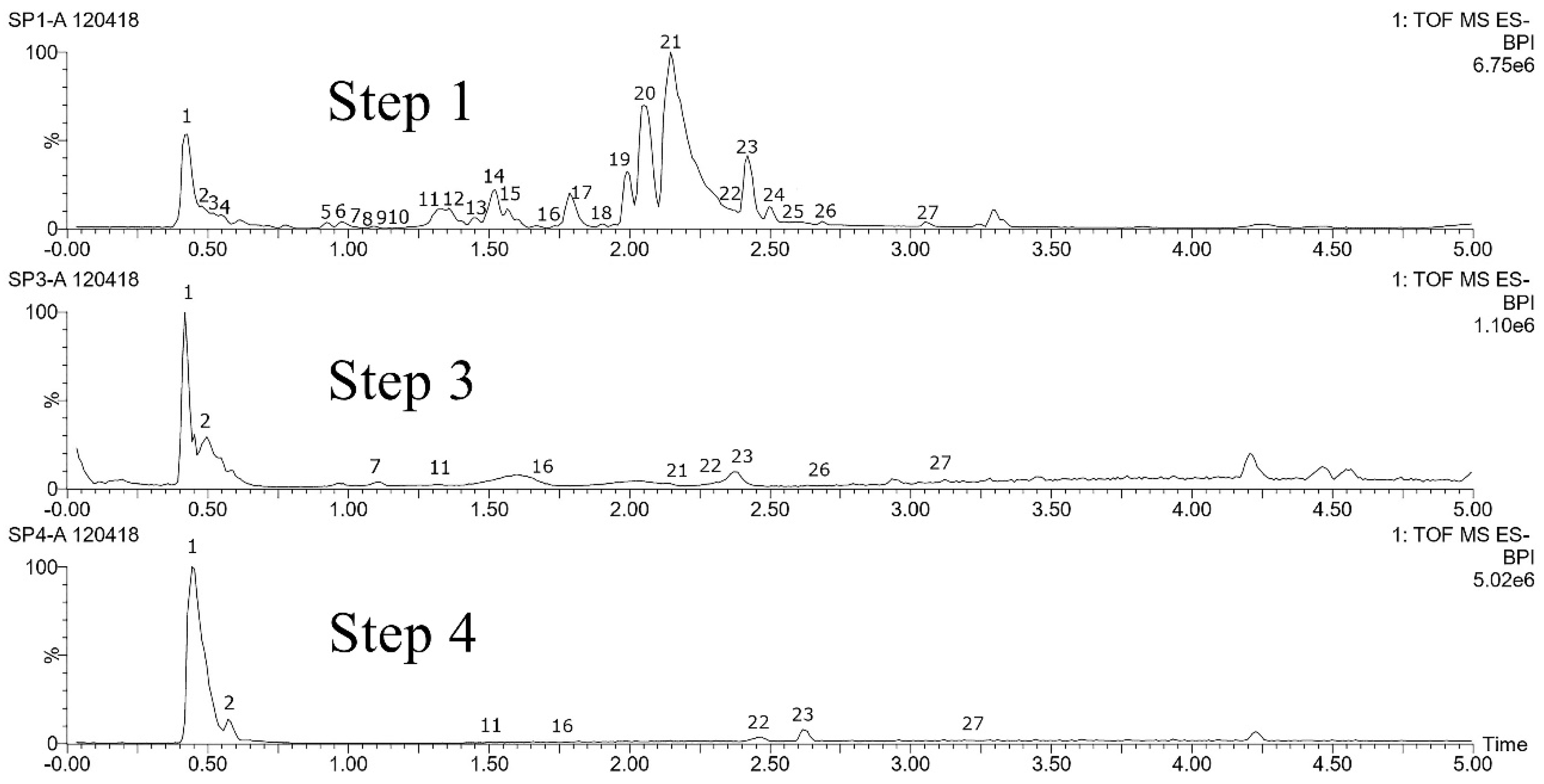
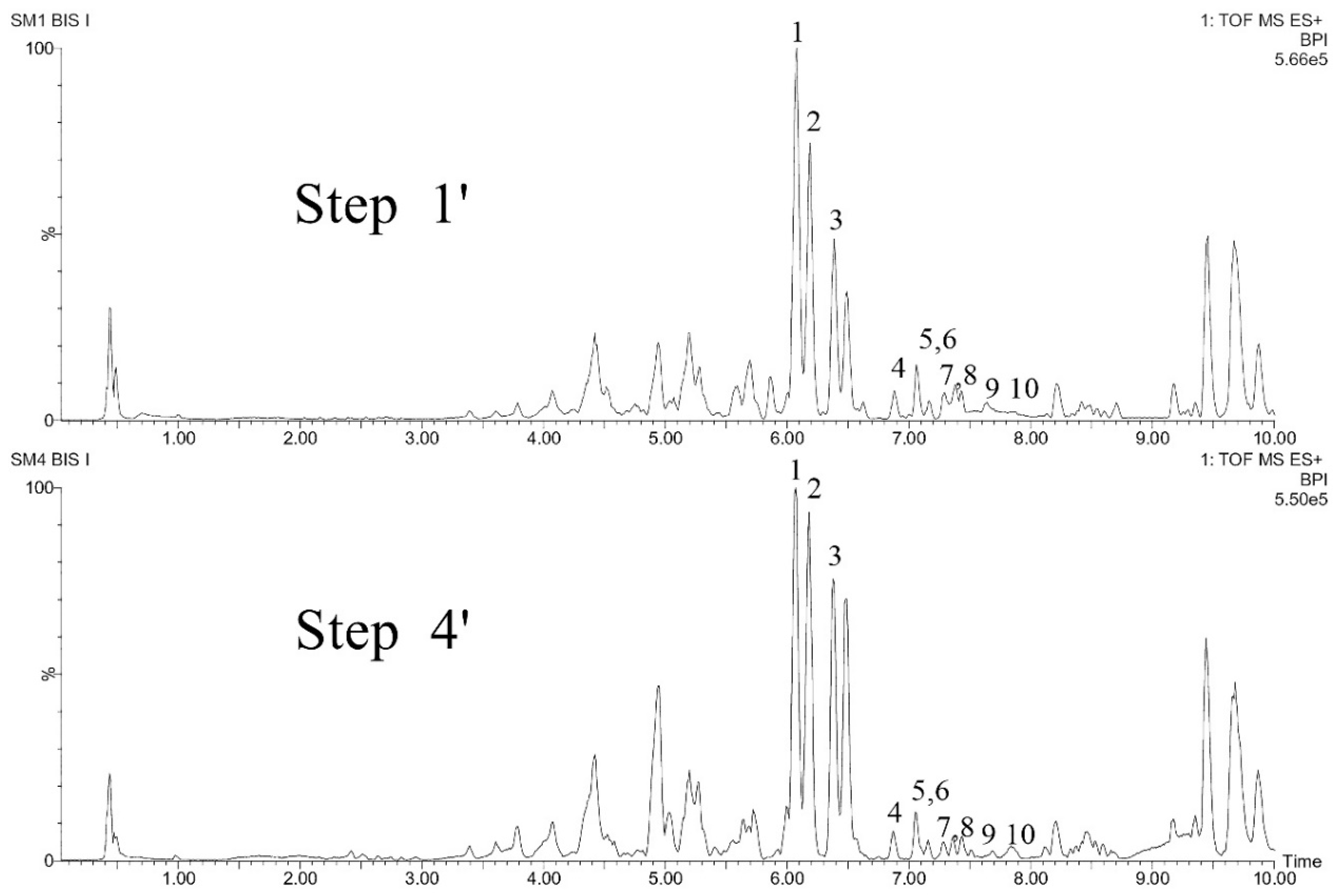
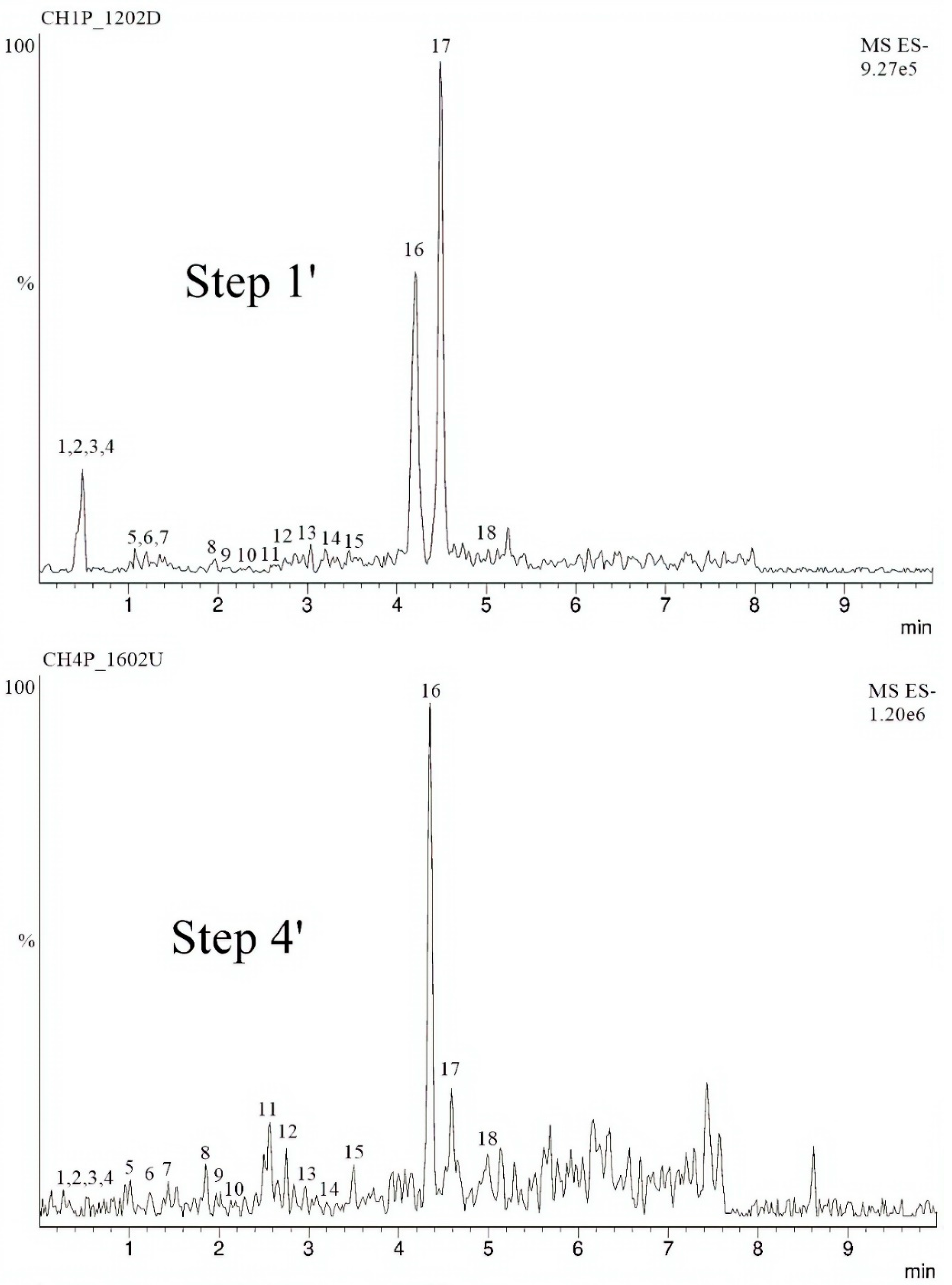
| Species Name [Botanical Family] | Herbarium Voucher Number | Type of Plant | Class of Compounds of Interest | Parts of the Plant Accumulating the Compounds | Ref |
|---|---|---|---|---|---|
| Physalis angulata L. [Solanaceae] | IAN 197200 | Herbaceous | Physalins (terpenoids) | Stems, leaves, fruits | [39] |
| Swietenia macrophylla King [Meliaceae] | IAN 197201 | Tree species | Limonoids | Leaves | [12,40,41] |
| Clidemia hirta (L.) D. Don [Melastomatacea] | IAN 197199 | Shrub | Tannins | Leaves | [42] |
| Calycophyllum spruceanum (Benth.) Hook.f. ex K. Schum. [Rubiaceae] | IAN 188633 | Tree species | Triterpenes | Leaves | NP |
| Vatairea guianensis Aubl. [Fabaceae] | IAN 187050 | Tree species | Isoflavonoids | Leaves and stems | [43,44,45] |
| Peperomia pellucida (L.) Kunth [Piperaceae] | IAN 197198 | Herbaceous | ArC2 dimers, flavonoids and bisnorlignans | Whole plant | [46,47] |
| Phyllanthus brasiliensis (Aubl.) Poir. [Phyllanthaceae] | IAN 185501 | Shrub | Flavonoids and lignans | Leaves | [48] |
| Stryphnodendron pulcherrimum (Willd.) Hochr. [Fabaceae] | IAN 199608 | Tree species | Tannins and Flavonoids | Stem bark and leaves | NP |
| Plant Species | Number of Compound Markers Which Presence Has Been Validated in Leaf Samples Collected “In Natura” (Step 0) | Proportion of Markers Detected After Pre-Cleaning (Step 1) | Proportion of Markers Detected After Cleaning of the Leaves (Steps 1–2) | Proportion of Markers Detected After Cleaning and Surface Sterilization (Steps 1–3) | Proportion of Markers Detected after 6 Days of Culture (Steps 1–4) |
|---|---|---|---|---|---|
| Physalis angulata | 18 (8 physalins and 10 unknown compounds) | 18/18 | 18/18 | 18/18 | 18/18 |
| Swietenia macrophylla | 10 limonoids | 10/10 | 10/10 | 10/10 | 10/10 |
| Clidemia hirta | 18 (2 phenolic acids, 2 glycosylated flavonoids, 5 ellagitannins and 8 unknown compounds) | 18/18 | 18/18 | 18/18 | 17/18 |
| Calycophyllum spruceanum | 12 (2 phenolic acids, 4 flavonoids and 6 unknown compounds) | 12/12 | 12/12 | 12/12 | 12/12 |
| Vatairea guianensis | 15 (3 flavones, 8 isoflavones and 4 unknown compounds) | 15/15 | 15/15 | 15/15 | ND |
| Peperomia pellucida | 09 (1 flavanoid, 1 lignan, 3 coumarins, 2 lactones and 4 ArC2 dimers) | 09/09 | 09/09 | 09/09 | 05/09 |
| Phyllanthus brasiliensis | 14 (7 flavonoids and 7 lignans) | 14/14 | 14/14 | 07/14 | 07/1 |
| Stryphnodendron pulcherrimum | 27 (11 tannins, 3 flavonoids and 13 unknown compounds) | 27/27 | 14/27 | 10/27 | 07/27 |
| Plant Species | Number of Compound Markers Selected from Mature Leaf Samples Collected “In Natura” | Proportion of Markers Detected in the Leaves of Young Axenic Plantlets (Step 1′) | Proportion of Markers Detected in Leaf Explants from the Axenic Plantlets after 6 Days of Culture (Step 4′) |
|---|---|---|---|
| Swietenia macrophylla | 10 | 10/10 | 10/10 |
| Clidemia hirta | 18 | 18/18 | 17/18 |
| Physalis angulata | 18 | 18/18 | 18/18 |
Sample Availability: Samples of the extracts of all plant species are available from the authors. |
Publisher’s Note: MDPI stays neutral with regard to jurisdictional claims in published maps and institutional affiliations. |
© 2020 by the authors. Licensee MDPI, Basel, Switzerland. This article is an open access article distributed under the terms and conditions of the Creative Commons Attribution (CC BY) license (http://creativecommons.org/licenses/by/4.0/).
Share and Cite
Joseph, R.C.; Silva da Fonseca Diniz, M.; Magno do Nascimento, V.; Barbosa Muribeca, A.d.J.; Costa Santiago, J.C.; da Cunha Borges, L.; da Costa Sá, P.R.; Portal Gomes, P.W.; da Silva Cardoso, J.C.; Rocha de Castro, M.N.; et al. Secure and Sustainable Sourcing of Plant Tissues for the Exhaustive Exploration of Their Chemodiversity. Molecules 2020, 25, 5992. https://doi.org/10.3390/molecules25245992
Joseph RC, Silva da Fonseca Diniz M, Magno do Nascimento V, Barbosa Muribeca AdJ, Costa Santiago JC, da Cunha Borges L, da Costa Sá PR, Portal Gomes PW, da Silva Cardoso JC, Rocha de Castro MN, et al. Secure and Sustainable Sourcing of Plant Tissues for the Exhaustive Exploration of Their Chemodiversity. Molecules. 2020; 25(24):5992. https://doi.org/10.3390/molecules25245992
Chicago/Turabian StyleJoseph, Rhodin C., Matheus Silva da Fonseca Diniz, Viviane Magno do Nascimento, Abraão de Jesus Barbosa Muribeca, Johan Carlos Costa Santiago, Luziane da Cunha Borges, Paulo Roberto da Costa Sá, Paulo Wender Portal Gomes, Júlio César da Silva Cardoso, Marcela Natalia Rocha de Castro, and et al. 2020. "Secure and Sustainable Sourcing of Plant Tissues for the Exhaustive Exploration of Their Chemodiversity" Molecules 25, no. 24: 5992. https://doi.org/10.3390/molecules25245992
APA StyleJoseph, R. C., Silva da Fonseca Diniz, M., Magno do Nascimento, V., Barbosa Muribeca, A. d. J., Costa Santiago, J. C., da Cunha Borges, L., da Costa Sá, P. R., Portal Gomes, P. W., da Silva Cardoso, J. C., Rocha de Castro, M. N., Fiusa, T., Rogez, H., Darnet, S., Pinheiro Arruda, M. S., Nascimento da Silva, M., Cardoso Arruda, A., Boutin, J. A., Silva, C. Y. Y. e., & Lautié, E. (2020). Secure and Sustainable Sourcing of Plant Tissues for the Exhaustive Exploration of Their Chemodiversity. Molecules, 25(24), 5992. https://doi.org/10.3390/molecules25245992










